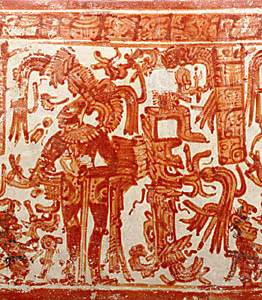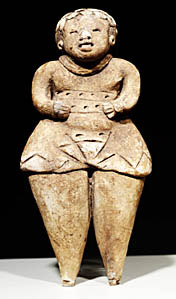With thirty years experience photographing Maya art, pyramid temple, palace, and ballcourt architecture, F.L.A.A.R. is the ideal place to come for courses and training to improve your photography. We now add instruction in digital photography, both entry level (Nikon CoolPix, Sony Mavica) all the way to upscale large format digital cameras (Dicomed, Better Light).
Digital Photography at the Maya Symposium
 |
| "Holmul Dancer" a well known motif in Maya art. |
Michael Collette of Better Light, recently developed the first direct digital rollout camera. This remarkable invention records the circumference of the Maya vases with no photographic film whatsoever. Instead the computer measures the size of the vase and then a light-sensitive sensor records every pixel on the surface of the vase circumference.
The result of doing this with a computer and not by trial and error, is, first of all, unprecedented accuracy. The computer even focuses the lens, and "develops" the image, instantly on the monitor.
The other result is remarkable color fidelity. But most of all, this incredible camera is so accurate that the rollouts can be enlarged in full color to 3 feet high by over 9 feet long. The FLAAR Photo Archive just received an ENCAD Nova Jet Pro digital printer which can print these rollouts at exhibit quality up to thirty feet long, in color!
The FLAAR crew of Nicholas and Andrea have been photographing Maya vases and bowls
day and night and weekend since June. Actually this camera is so flexible that it can even do a
rollout of the inside of a Maya plate or large bowl!
The reason for all this effort is to insure that people who come to Florida will have the opportunity to experience a corpus of Maya material which is unprecedented in its quality, and quantity.
Sunday (Feb. 15th) is for anyone who would like to learn how to take rollout photographs themselves.
 |
Although the principle of rollout photography has been known since the 1940's, there has never been a complete blueprint of any rollout system actually published. Now is the first time that the detailed mechanism of rollout photography is available to anyone who would like to know about it.
You can use the camera yourself. No previous experience is required.
We ask a donation since this session is rather obviously intended just for one or two people, so that each individual gets full personal instruction on every aspect of the camera.
And, if you would like to acquire any rollout camera for yourself, or for your museum or project, we have extra cameras available (we currently have three active rollout cameras, two which use 70mm film, and one which is digital). The entire digital system is well over $40,000 but we have a sophisticated 70mm rollout camera, for $20,000, which requires no computer since it is completely calibrated in advance. This particular camera is actually far more accurate than others which rely on trial and error to estimate the rotational speed. This trial and error estimate results in awkward and rather visible stretch or compression of the artifact being photographed.